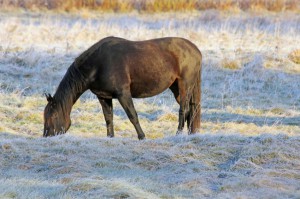 Frosty grass can contain high levels of Fructans. Sugar levels in grass are constantly changing, and it is well-known that the Autumn and Spring flush are times that are potentially problematic for grazing. Consuming excessive amounts of fructans (the stored sugar in grass) is considered a trigger factor for laminitis. These sugars are produced by the grass via a process known as photosynthesis. Photosynthesis is a chemical reaction where carbon dioxide and water are converted into sugar and oxygen, and in order to fuel this reaction, light energy is needed, which is absorbed by the green pigment in plants known as chlorophyll. Because sunlight is necessary for the reaction to take place, photosynthesis only occurs during daylight hours. The sugars are produced in the leaves and used as fuel for respiration, but any excess sugar is converted into a storage carbohydrate, known as fructan, which is then stored in the stem. Overnight these sugars are used to provide energy for growth, and extra sugars not used are stored, usually in the lower stem (the 2 inches above soil level). If, however, the temperature drops below 4.5˚C, growth does not occur, and so the sugar remains in high concentrations in the grass. For this reason, sunny days followed by cold nights means that sugar levels in grass are high, and they continue to rise if this weather continues for a period of time. This effect is worsened for horses on short, over grazed grass, as the sugars are stored in the lower stem, next to the earth. As a quick guide, fructan levels are: HIGH in stressed, over grazed pastures HIGH when night temperatures drop lower than 4.5 ˚C HIGH in the afternoons/evening when it has been sunny LOW in cloudy, rainy weather conditions LOW in the mornings when nights are warm and days are sunny If you have a horse or pony prone to laminitis it is wise to not let them graze during high risk times. Instead, keep them stabled or ideally on non-grass turnout. Feedmark Fibre blocks are a great low starch and sugar way to keep them entertained, especially if you put them in a haylage net! To make sure that your laminitic pony is still receiving a balanced diet without getting any grass, you could feed Prolamin, the only two part laminitis supplement that provides a vitamin and mineral supplement alongside beneficial antioxidant herbs that support the circulatory system. Olivia Colton MSc, Nutritional and Technical Coordinator, Feedmark For advice or nutritional guidance please call 0800 585525 to talk to one of our nutritional advisors, or look at our website.
Frosty grass can contain high levels of Fructans. Sugar levels in grass are constantly changing, and it is well-known that the Autumn and Spring flush are times that are potentially problematic for grazing. Consuming excessive amounts of fructans (the stored sugar in grass) is considered a trigger factor for laminitis. These sugars are produced by the grass via a process known as photosynthesis. Photosynthesis is a chemical reaction where carbon dioxide and water are converted into sugar and oxygen, and in order to fuel this reaction, light energy is needed, which is absorbed by the green pigment in plants known as chlorophyll. Because sunlight is necessary for the reaction to take place, photosynthesis only occurs during daylight hours. The sugars are produced in the leaves and used as fuel for respiration, but any excess sugar is converted into a storage carbohydrate, known as fructan, which is then stored in the stem. Overnight these sugars are used to provide energy for growth, and extra sugars not used are stored, usually in the lower stem (the 2 inches above soil level). If, however, the temperature drops below 4.5˚C, growth does not occur, and so the sugar remains in high concentrations in the grass. For this reason, sunny days followed by cold nights means that sugar levels in grass are high, and they continue to rise if this weather continues for a period of time. This effect is worsened for horses on short, over grazed grass, as the sugars are stored in the lower stem, next to the earth. As a quick guide, fructan levels are: HIGH in stressed, over grazed pastures HIGH when night temperatures drop lower than 4.5 ˚C HIGH in the afternoons/evening when it has been sunny LOW in cloudy, rainy weather conditions LOW in the mornings when nights are warm and days are sunny If you have a horse or pony prone to laminitis it is wise to not let them graze during high risk times. Instead, keep them stabled or ideally on non-grass turnout. Feedmark Fibre blocks are a great low starch and sugar way to keep them entertained, especially if you put them in a haylage net! To make sure that your laminitic pony is still receiving a balanced diet without getting any grass, you could feed Prolamin, the only two part laminitis supplement that provides a vitamin and mineral supplement alongside beneficial antioxidant herbs that support the circulatory system. Olivia Colton MSc, Nutritional and Technical Coordinator, Feedmark For advice or nutritional guidance please call 0800 585525 to talk to one of our nutritional advisors, or look at our website.
Les cookies nous permettent d'offrir nos services. En utilisant nos services, vous acceptez notre utilisation des cookies.











